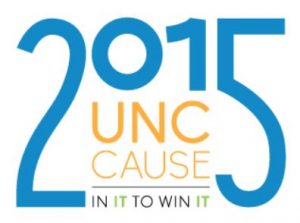
 At the 2015 UNC Cause, Morgon Haskell, Support Specialist with ITS Teaching & Learning, led a session about the lifecycle of integrating non-native applications with the Sakai learning environment. In this guest blog post, Haskell shares some highlights.
At the 2015 UNC Cause, Morgon Haskell, Support Specialist with ITS Teaching & Learning, led a session about the lifecycle of integrating non-native applications with the Sakai learning environment. In this guest blog post, Haskell shares some highlights.
As richer learning Web applications come on the market, it is important to have a standardized solution to integrate third-party Web-based applications into any learning-management system. Learning Tools Interopability (LTI) is becoming the standard framework to make that happen. LTI provides a secure way of passing a user from Sakai to a third-party application, such as Blackboard Collaborate for video conferencing or VoiceThread for digital storytelling. Roles in Sakai are also transferred to the Web apps, which make provisioning accounts and access control manageable from within Sakai. From the end users’ perspective, the application is launched within Sakai and feels like a native tool.
How do you vet applications?
During the UNC Cause session, we discussed a wide range of topics that focused on the lifecycle of integrating non-native applications with Sakai. Participants were primarily interested in governance and the process to vet a given application. Most of the universities represented during this session were on different LMSs but that didn’t detract from the common question of how to best implement and manage requests for Web-based applications.
How do you decide which tools to integrate?
There seemed to be consensus that LTI was the most practical means to integrate applications but the broader question remained: how do you decide what tools should be integrated at the system level and how do you manage them? Here at UNC-Chapel Hill we have the Sakai Enhancements Committee (SEC) and North Carolina State University has a process as well. But many of the other schools are still trying to answer that question.
What if multiple providers offer the same service?
Another interesting topic that emerged focused on deciding which tool is best suited for integration when there is more than one third-party Web application that offers the same service. An example of this would be student-response systems and the vendors that offer devices and cloud-based services to poll students during class.
Since this session was on the Teaching and Learning track for UNC Cause, most of the participants were like-minded individuals who had questions about best supporting and extending their LMS. Security and ID management were discussed, questions were asked about governance, and we briefly touched on the topic of removing tools from an LMS.
One of the benefits of attending and presenting at UNC Cause is the interaction between the different North Carolina universities and the questions that come up. The group was engaged and we were able to discuss several topics all centralized on the theme of integrating non-native Web-based applications into a, LMS.
